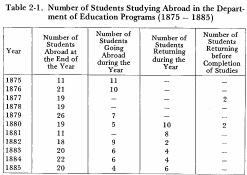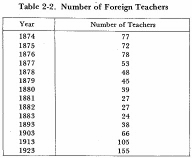- 現在位置
- トップ > 白書・統計・出版物 > 白書 > JAPAN'S MODERN EDUCATIONAL SYSTEM > d. Japanese Students Studying Abroad and Foreign Teachers in Japan
d. Japanese Students Studying Abroad and Foreign Teachers in Japan
The dispatch of Japanese students abroad for study played an important role in the introduction of Western culture and in the training of young men of promise during the early years of the Meiji era. The practice had begun in the final years of the Shogunate and following the Meiji Restoration, the number of persons sent abroad for study increased quite markedly. Already between 1868 and 1872, to the United States alone some five hundred students were sent. It was for this reason that the Education System Order contained such detailed regulations for students abroad.
According to figures contained in the first Annual Report of the Department of Education for 1873 issued in 1875, there were 373 students studying abroad of which 250 were subsidized by the government. From its inception, the Department had held that sending students abroad was an important way of achieving the objective of training people to take charge of instruction in the higher level schools of Japan.
Whereas a large proportion of the students selected for overseas study came from samurai families, they were not necessarily the proper choice and had come to be even considered as cases of misuse of government scholarships. Thus, in December 1873, the government decided to recall all students studying abroad. However, several students from Tokyo Kaisei Gakko - predecessor of the University of Tokyo - were selected in March, 1875, and in July nine were sent to the United States and one each to France and Germany.
In May, 1875, the Department of Education established stringent regulations concerning loans for students studying abroad and invited applicants throughout the country - indeed the rules were so severe that no applicant could suit the Department's new request. Again the students were selected from Tokyo Kaisei Gakko and in June of the following year eight students left for England and two more for France.
Table 2-1. Number of Students Studying Abroad in the Department of Education Programs (1875-1885)

The students selected were promising young men between the ages of seventeen and twenty-two who were to specialize primarily in law, chemistry and engineering. Apart from this program, in July, 1875, three young students including Izawa Shuji (1851-1917) were sent by the Department of Education to the United States to pursue studies in teacher training; and in1879 three graduates of the Law, Literature and Science Faculties of the University of Tokyo were sent to England and one to France. That same year three graduates of the Medical Faculty went to Germany.
In the early years of the Meiji era a considerable proportion of the higher education in Japan was entrusted to foreign teachers. In the April 28, 1873 supplementary regulations of the Education System Order, specialized schools were authorized and encouraged to employ foreign teachers and offer courses in Western culture and technology. These courses were to be on law, medicine, astronomy, mathematics, physics, chemistry, engineering and others.
Table 2-2. Number of Foreign Teachers

Tokyo Kaisei Gakko offered foreign language courses for students who wished to specialize in English, French or German from the time when the school was called the Southern College of the University (Daigaku Nanko). These courses were under the direction of a large number of both native born and foreign instructors. There were eight British and American teachers and five French and four German teachers under the supervision of Head Teacher Guido Verbeck. In August, 1871, the Eastern College of the University (Daigaku Toko), predecessor of Tokyo Medical School (Tokyo Igakko), invited German Army Surgeons Leopold Muller (?-1893) and Theodor E. Hoffmann to lecture on field medical procedure thus introducing German medical studies to Japan. Thereafter the number of foreign teachers in Japan increased annually until it reached 78 individuals in 1876. After that year as successive groups of Japanese students returned upon completion of their studies abroad, the number of foreign teachers employed by the Department of Education gradually decreased. Among the foreign teachers were many who contributed important services to the cause of education in the early years of the Meiji era.
お問合せ先
(C)COPYRIGHT Ministry of Education, Culture, Sports, Science and Technology
-- 登録:平成21年以前 --